Key Insights
- Average daily active addresses increased 75% QoQ to 70,200. Growth was largely driven by universal basic income protocol GoodDollar, which averaged 46,400 daily active Celo addresses.
- Celo began its transition to an Ethereum L2 with the Gingerbread Hardfork. Celo L2 will initially leverage the OP Stack with EigenDA and a decentralized sequencer set to maintain some of its existing properties such as 1-block finality time and cheap transaction fees.
- Web browser Opera integrated its new stablecoin wallet MiniPay into its mobile web browser Opera Mini. Opera Mini is one of the more popular mobile browsers in Africa, with an 11% market share.
- The Ultragreen Money proposal to refine CELO tokenomics was implemented. Celo now burns 80% of a transaction’s base fee and distributes the other 20% to a new Green Fund that targets regenerative finance initiatives.
- QoQ growth in transactions and new addresses was driven by LayerZero activity. In Q3, 43% of new addresses interacted with LayerZero contracts on the same day they joined the network, but the lack of further ecosystem participation indicates airdrop farming.
Primer on Celo
Celo is a Layer-1 network in transition to a Layer-2 focused on real-world blockchain use cases such as payments and regenerative finance. After raising $36.5 million in two private fundraising rounds, Celo mainnet launched on Earth Day in 2020. Soon after, a public sale for Celo’s native token CELO raised $10 million on CoinList. In early 2021, Celo raised $20 million in another private round. Development and growth of Celo’s network and ecosystem were initially led by cLabs and the Celo Foundation. While these entities are still involved, development and growth has become more community-driven, with participation from a distributed group of projects and DAOs.
At the beginning of 2023, cLabs introduced the Celo 2.0 roadmap, detailing plans to align more closely with Ethereum, optimize Celo’s EVM, refine CELO tokenomics, and more. In July 2023, cLabs posted a proposal to migrate to an Ethereum Layer-2 using the OP Stack. The migration took its first official step toward becoming an L2 with the Gingerbread Hardfork at the end of September. Another hardfork will be required for the transition, with its exact date to be determined.
Key Metrics

Financial Analysis
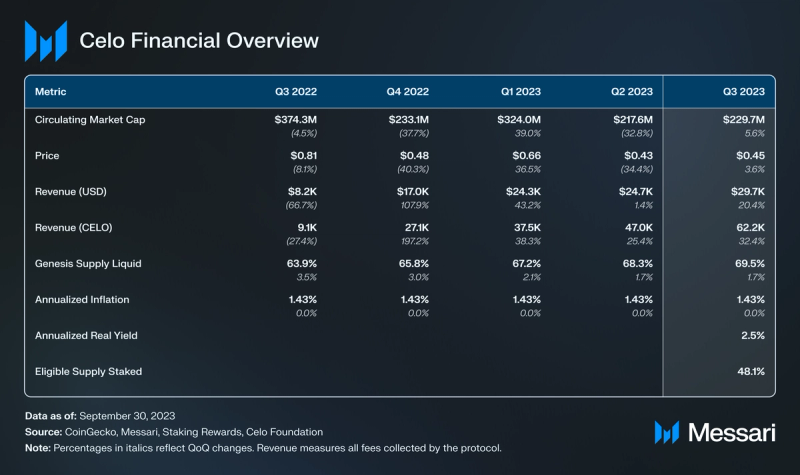
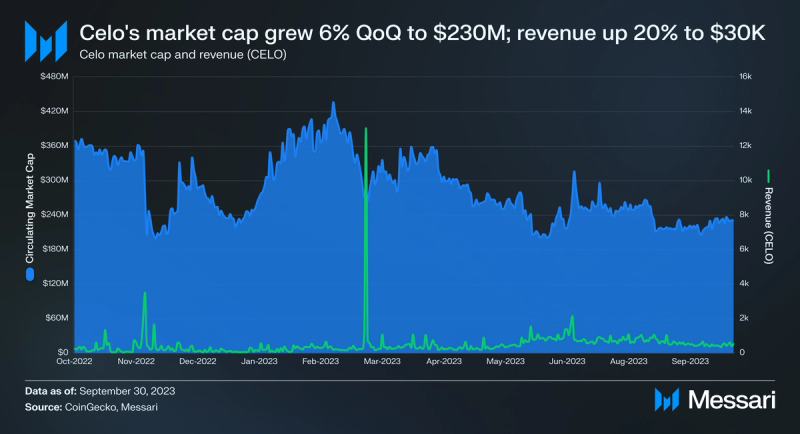
Q3’23 featured a quieter crypto market that largely traded sideways. The one major exception was a selloff in mid-August. CELO followed this trend – its circulating market cap decreased by 17% from August 15-18. Despite this, CELO’s market cap rose QoQ, up 6% to $229.7 million. Its market cap rank, however, decreased slightly QoQ, from 111 to 115.
Celo’s revenue (gas fees collected by the protocol) denominated in CELO increased 32% QoQ to 62,200 ($29,700), indicating increased demand for Celo blockspace. Celo’s average transaction fee in Q3 was $0.0012. Transaction fees are designed to be low to support real-world use cases.
The Gingerbread Hardfork, completed on September 26, implemented CIP-52. The proposal introduces a new system for how revenue is distributed. Previously, the base fee of a transaction was sent to a Community Fund while the tip was rewarded to the block proposer.
Under the new system, 20% of the base fee is allocated to a new Green Fund. The Green Fund will start as a multi-sig and will receive the existing assets in the Celo Carbon Offset Fund. Its purpose will be to turn assets into onchain Regenerative Finance (ReFi) initiatives, such as buying carbon credits. The other 80% of each transaction’s base fee is now being burned. Note that transaction fees can be paid in any ERC-20 token approved by onchain governance, not just CELO. Fees paid in ERC-20s are converted to CELO in order to be burned but are transferred to the Green Fund as is.
Inspired by Ethereum, the system was dubbed “Ultragreen Money”. Related metrics such as Celo’s carbon footprint, carbon offset funding, and transaction fees can be tracked on the Ultragreen Money dashboard.
Inflationary pressure to CELO comes from genesis supply unlocks and epoch validator rewards. At the end of Q3, 69.5% of CELO’s genesis supply was liquid. The genesis supply here excludes staking rewards and totals 700 million tokens. In Q4, another 1% of genesis supply will unlock across the team and advisors, and community and operational grants buckets. The annualized inflation rate of 1.43% measures the rate of staking rewards compared to the genesis supply total of 700 million tokens. This rate is set to remain at 1.43% until 2035, when it will then begin decreasing and eventually go to zero.
Network Analysis
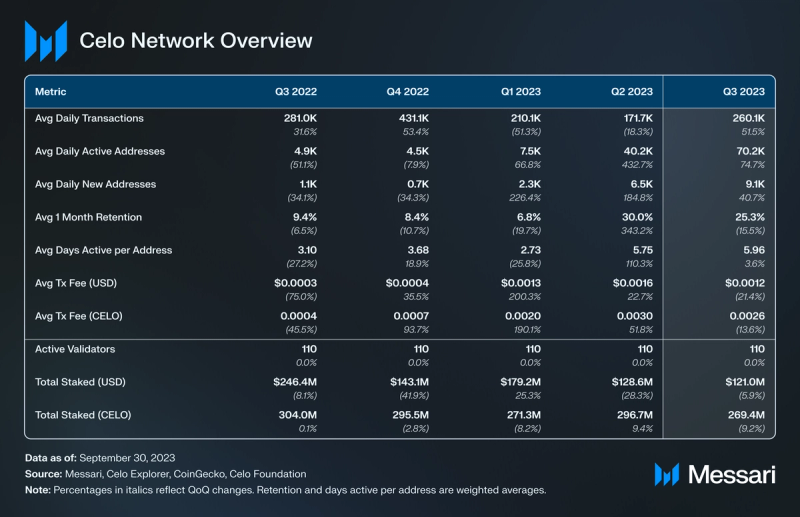
Usage
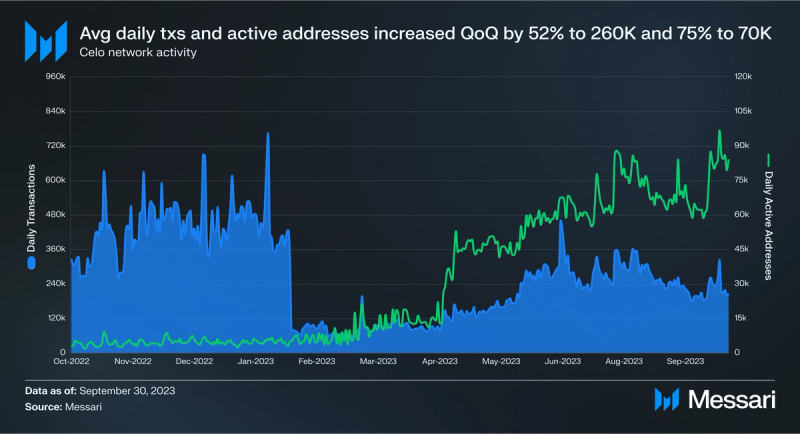
Average daily active addresses continued its upward trend in Q3, increasing 75% QoQ to 70,200. Average daily transactions also grew notably QoQ, up 52% to 260,100. The number of daily transactions have rebounded since its significant drop right at the end of January 2023. A governance proposal at that time increased the base fee, which likely made it unprofitable for bots to exploit small arbitrage opportunities. The increase in network usage was driven by several applications, including GoodDollar and LayerZero.

GoodDollar is an onchain universal basic income (UBI) experiment. The protocol mints and distributes the token G$ on a daily basis to verified global smartphone users. G$ is partially backed by a reserve pool, which lives on Ethereum. In mid-March, G$ distribution officially expanded to Celo, joining Ethereum sidechain Fuse. Near the end of April, GoodDollar’s native mobile wallet GoodWallet integrated with Celo, spurring usage of the protocol on the network.
In Q3, GoodDollar averaged 46,400 daily active addresses on Celo, accounting for 66.5% of Celo’s daily active addresses on average. In Q3, GoodDollar had 222,700 total active addresses. The relatively high daily active addresses to quarterly active addresses (DAA / QAA) ratio of 21% indicates that GoodDollar addresses are highly active. As of September 30, G$ has a circulating market cap of $1.3 million.
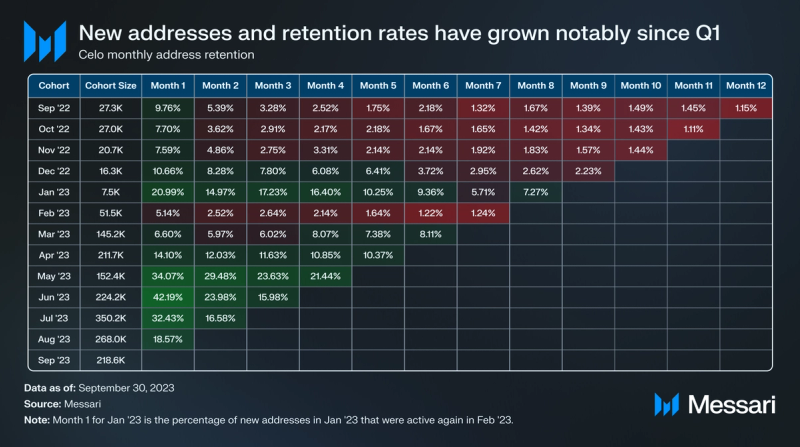
Average daily new addresses similarly increased 41% QoQ to 9,100 and is now up 727% YoY. These new addresses were also retained at a higher rate than previously. Although the weighted average 1 month retention rate dipped 16% QoQ, it is still up 169% YoY at 25.3%. Again, the increases in new addresses and retention rates were primarily driven by GoodDollar and LayerZero.
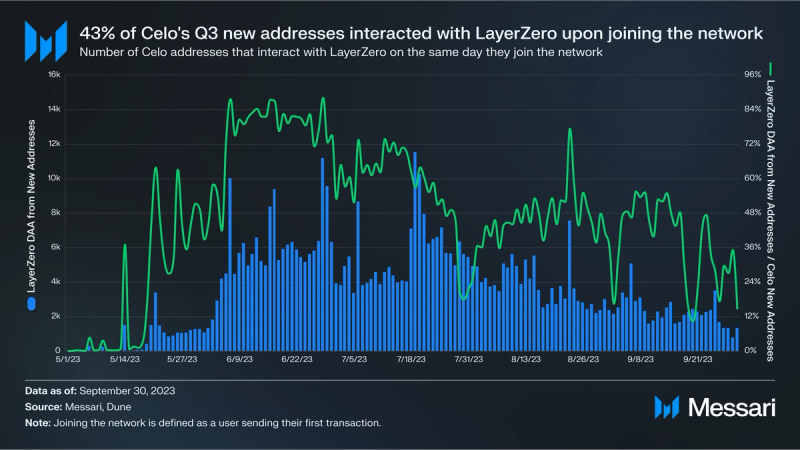
Interoperability protocol LayerZero launched on Celo in December 2022. Its Celo-based activity remained very low until May when it began driving a significant portion of Celo activity. The above chart shows addresses that interact with LayerZero on the same day that they join the network. It also compares these figures to Celo’s total daily new address count. In June, Celo had 224,200 total new addresses, 172,600 (77%) of which interacted with LayerZero upon joining. In Q3, this share cooled off a little to 43%. This trend was not exclusive to Celo, with LayerZero driving a lot of networks’ usage in Q2 following its $120 million Series B fundraising announcement on April 4.
The vast majority of addresses interacting with LayerZero have not penetrated further into the Celo ecosystem, indicating that they are primarily airdrop farming. In Q3, there were 836,800 new Celo addresses, 404,300 (48%) of which interacted with a LayerZero contract at any point in the quarter (rather than solely on the same day they joined). Of these 404,300 new addresses in Q3 that interacted with LayerZero:
- 52.4% also interacted with Polyhedra, a zkBridge built on top of LayerZero;
- 45.4% with agEUR, a euro stablecoin by Angle that migrated to LayerZero’s Omnichain Fungible Token (OFT) standard; and
- 3.2% with Merkly, an NFT bridge built on top of LayerZero.
The top non-LayerZero-related contracts these addresses interacted with are the CELO token contract (3.0%), stablecoin protocol Mento (2.1%), and DEX Ubeswap (1.6%). Furthermore, in contrast to GoodDollar, LayerZero had a relatively low DAA/QAA ratio of 2.8%. This could indicate that users created many different wallets and expected airdrop requirements based on monthly rather than daily activity.
Security and Decentralization

At the end of the quarter, there was 270.3 million CELO staked ($121.4 million), representing 48.1% of the supply eligible to be staked. The number of active validators on Celo remained at 110 in Q3. Several validator operators run more than one validator node on the Celo network. There were around 83 validator operators at the end of the quarter.
In Q3, two companies announced plans to run a Celo validator, Telefonica and Google Cloud. Google Cloud and cLabs have previously partnered in ecosystem growth initiatives. As part of the continued partnership, cLabs will leverage Google Cloud’s Blockchain Node Engine to streamline Celo’s transition to an Ethereum Layer-2 (L2).
In Celo’s transition to an Ethereum L2, discussed in further detail below, Celo’s validator set will become a decentralized sequencer set. In addition to running an updated client, validator operators will need to run an Ethereum node or have access to a trusted one. The sequencers will enable Celo to maintain its 1-block finality secured by CELO stake, while also leveraging EigenDA and Ethereum for stronger, albeit less frequent finality guarantees. Validators will be slashed if they share divergent blocks on the Celo and data availability layer to avoid sequencer-caused block reorgs. The exact design details for mitigating Ethereum reorgs that will then cause Celo reorgs is being explored.
Upgrades and Roadmap: Celo L2
In mid-July, cLabs posted a forum proposal to transition Celo to an Ethereum L2. The post proposes to initially leverage the OP Stack while making some modifications to maintain several of Celo’s current properties including 1-block finality, reorg resistance, and low transaction fees. As noted above, Celo validators will transform into sequencers, becoming one of the first L2s with a decentralized sequencer set. However, the OP Stack fraud proof system is still under development.
Transaction batches will be posted to EigenDA, an offchain data availability layer that is secured by restaked ETH through EigenLayer. Sequencers will be slashed if they publish a different transaction batch from the one they signed during the Celo consensus phase. Using offchain rather than onchain data availability will prevent any significant increase to Celo’s transaction fees. Data availability certificates will then be posted to Ethereum. Doing so brings an additional Ethereum finality stage to Celo transactions every two Ethereum epochs when Ethereum blocks are finalized.
Other advantages to the transition include enhanced compatibility with Ethereum tools and libraries and a native bridge to Ethereum, which will increase the composability of apps and liquidity between the two networks. Furthermore, the migration is just as much of a social one as it is a technological one. Becoming an Ethereum L2 will align the Celo community and ecosystem much more closely with Ethereum.
The proposal was widely celebrated in the Ethereum ecosystem, receiving feedback and praise from Vitalik, Sreeram, Dankrad, Joseph Lubin, among others.
At the end of July, the proposal passed a temperature check. Then, at the end of the quarter, the Gingerbread Hardfork was completed. Gingerbread is the first official step toward becoming an Ethereum L2. Key modifications include the following:
- The removal of certain Celo Improvement Proposals (CIPs) that increase the difference between Celo and Ethereum.
- The introduction of a new transaction type named “envelope transaction” tailored for the L2 upgrade.
- Setting a block size limitation to maintain communication efficiency between nodes.
As noted above, Gingerbread also altered how base transaction fees are distributed, with 80% burned and 20% allocated to a Carbon Offset Fund.
Some exact details of the L2 implementation are still being researched and ironed out. Notably, both Polygon Labs and zkSync’s Matter Labs posted forum proposals for Celo to use the Polygon CDK and ZK Stack, respectively, instead of the OP Stack. These L2 stacks both feature tools to deploy rollups that are zero-knowledge rather than optimistic. In its initial proposal, cLabs noted that it expects to eventually upgrade Celo to a validium-based zkEVM once the zk-L2-stack offerings mature.
Ecosystem Analysis
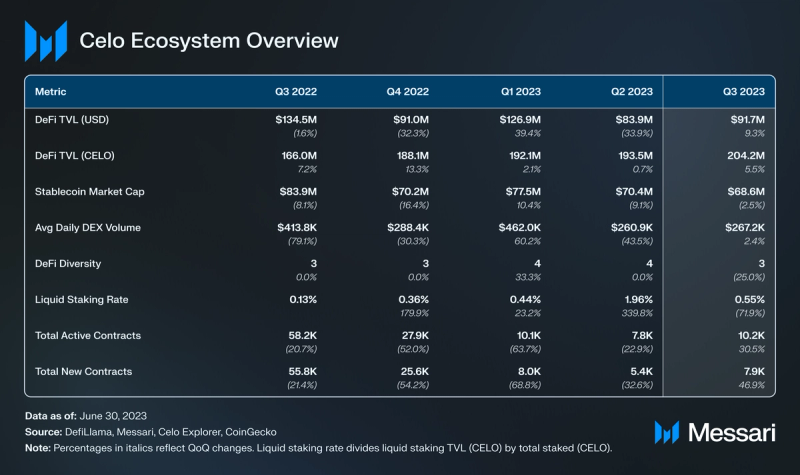
DeFi
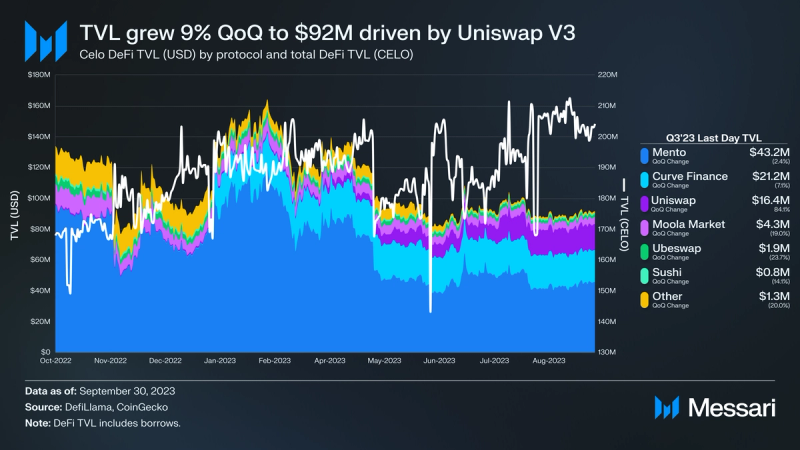
Celo’s DeFi TVL increased 9% QoQ to $91.7 million, ranking it roughly 21st among all networks. Stablecoin protocol Mento accounted for 48.5% of this TVL. Mento mints the stablecoins cUSD, cEUR, and cREAL, which are backed by a reserve featuring CELO, DAI, USDC, and other digital assets. Mento was originally developed by cLabs before Mento Labs spun out in February 2023.
Curve and Uniswap V3 both launched on Celo in the second half of 2022. Almost all of the TVL in Curve’s Celo instance is in a pool containing cUSD and USDCet (Wormhole-wrapped Ethereum USDC). Uniswap’s TVL on Celo increased 84% QoQ. In mid-August, a Celo governance proposal passed to consolidate Mento Reserve funds in Uniswap V3 wETH (Axelar) / wETH (Wormhole) and CELO / stCELO pools into a CELO / wETH (Wormhole) pool. Mento, Curve, and Uniswap accounted for over 90% of Celo’s total DeFi TVL, giving it a DeFi Diversity score of 3.
At the end of June, Chainlink’s data feeds went live on Celo. The integration comes after Celo joined Chainlink’s SCALE program in April. The program subsidies transaction fees and other operating costs of Chainlink oracle networks for a period of time to help developers bootstrap their application.
In mid-August, an Aave temperature check vote passed to deploy its V3 protocol on Celo. The proposal states that the Celo Foundation will allocate 0.5% of CELO circulating supply as incentives to bootstrap growth. Earlier in the year, Mento Labs also proposed returning the 120 million CELO that was allocated to the Mento Reserve in Celo’s genesis block to bootstrap the cUSD reserve. Mento’s stablecoins are backed 1:1 by a combination of DAI and USDC. With the additional CELO and other assets in the reserve, the stablecoins have around a 2.6 overcollateralization ratio. Thus, there have been discussions about placing this 120 million CELO in Aave to boost onchain liquidity.
Stablecoins and Payments
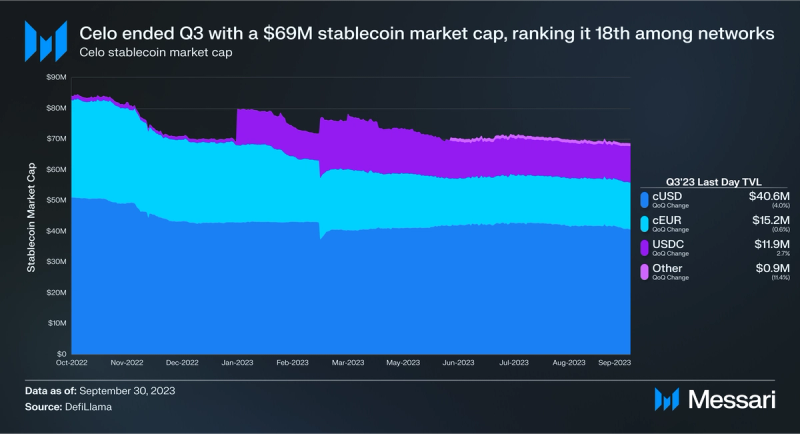
Celo finished the quarter with a $68.8 million stablecoin market cap, ranking it 18th among all networks. Compared to many other networks, Celo users can pay gas fees in approved stablecoins, enhancing user experience especially in real-world use cases. Unlike other top networks, Celo’s stablecoin market cap is largely made up of native stablecoins. Mento’s cUSD led with $40.6 million, followed by Mento’s cEUR at $15.2 million.
In mid-July, cLabs released payments SDK SocialConnect. SocialConnect allows wallets to map a user’s public blockchain address to their phone number, email address, or other social identifier in a privacy preserving manner. Users can then transfer tokens using those credentials across any wallet that integrates the tool. Upon launch, several Celo wallets integrated SocialConnect, including Node Finance, Kaala, Libera, and Valora. cLabs also plans on launching SocialConnect on Ethereum and Polygon. SocialConnect joins on/off-ramp API standard FiatConnect as tools enabling wallets to more easily support payments.
In mid-September, web browser Opera launched stablecoin wallet MiniPay, powered by SocialConnect and FiatConnect. MiniPay is natively integrated to Opera’s mobile web browser Opera Mini, one of the more popular mobile browsers in Africa with an 11% market share. To ease onboarding, users create an account using their Google credentials, with their private keys automatically backed up to their Google Drive. Users can then send and receive Mento stablecoins using phone numbers, with all transactions on the Celo network. MiniPay is currently live in Nigeria, with more markets coming soon.
Near the end of August, Glo Dollar launched on Celo. Glo Dollar is a stablecoin backed by a reserve of cash and U.S. Treasuries. A portion of the revenue earned from the treasuries yield is donated to GiveDirectly, a non-profit that distributes basic incomes to people in extreme poverty. Glo Dollar’s circulating market cap on Celo at the end of Q3 was around $100,000.
ReFi
Regenerative Finance (ReFi) merges DeFi with regenerative economic principles, aiming to solve environmental and social issues with blockchain technology. Creating a positive social impact has been at the forefront of Celo’s mission since its launch. As such, Celo is one of the leading ecosystems for ReFi projects, including GoodDollar, impactMarket, Toucan, Kolektivo, and more.
As noted above, UBI project GoodDollar has been driving Celo daily active address activity following integration in mid-March. Right after the quarter ended, GoodDollar announced its Prosperity Grants Program, offering $75,000 worth of G$ to educators, ambassadors, and builders furthering GoodDollar within the Celo ecosystem.
At the beginning of the quarter, the Celo Foundation commissioned carbon offsetting NFT Celosapien from Ecosapiens. The NFT is dynamic, evolving to reflect Celo’s carbon offset progress. The Celosapien Open Edition NFT has so far been minted by over 42,000 addresses. At the end of Q3, Celo’s lifetime net carbon footprint stood at -4,233 tons of CO2, with offsets largely facilitated by Toucan and Wren.
Near the end of August, onchain carbon market Thallo deployed its two-way carbon bridge on Celo. The bridge allows carbon credits in registries to be securely represented onchain. Thallo was one of the inaugural grant recipients of the Climate Collective’s Celo grants program.
Development and Growth
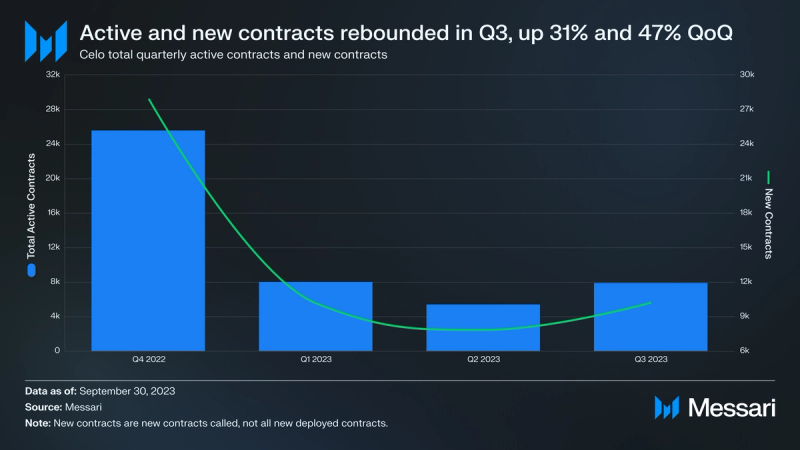
Ecosystem development and growth is driven by the Celo Foundation and cLabs, as well as other organizations and coalitions. Notable events from Q3 include:
- Celo Camp Batch 7: Celo Camp is an eight-week virtual accelerator program created by the Celo Foundation and Upright in 2020. At the end of July, the Celo Foundation announced the winners from the seventh cohort, which featured 30 participants. Top prize winners included offramp Ripe (10,000 cUSD and 2,000 CELO) and creator platform Lemonade (5,000 cUSD and 1,000 CELO). Applications for Batch 8 are open until January 2024.
- ETHGlobal Celo Hackathon Tracks: The Celo Foundation sponsored hackathon tracks at several ETHGlobal events in the quarter, including ETHGlobal Paris and ETHGlobal NYC. Top prize winners included undercollateralized lending protocol Vouch ($3,000) and non-custodial NFC card Bounce ($3,000). In Q4, Celo Foundation’s Developer Relations team will be at ETHGlobal Instanbul and ETHIndia.
- Co:OPERATE: The Celo Foundation cohosted a three-day event with Chainlink during EthCC, featuring a ReFi, Builder, and Mobile day.
- The Value Prop: Near the end of August, the Celo Foundation joined The Value Prop, a platform and initiative founded by Polygon Labs in June to highlight real-world use cases of blockchain technology. Celo projects with featured testimonials include GainForest, EthicHub, Toucan, ReSource Finance, and Talent Protocol.
- Gitcoin Pools: The Celo Foundation, along with Celo Europe and Konekti DAO, funded a 30,000 cUSD Gitcoin matching pool for ReFi DAO’s Local Node beta cohort. The program’s goal is to form a global group of local regenerative leaders who host events and onboard talent and capital into ReFi. Several other projects on Celo raised funding in Gitcoin’s 18th round of grants, including Silvi, Glo Dollar, GoodDollar, and Grassroots Economics.
Closing Summary
Q3 2023 was a memorable quarter for the Celo network, featuring the introduction and official beginning of its transition to an Ethereum L2. Celo L2 will initially leverage the OP Stack with EigenDA and a decentralized sequencer set to maintain some of its existing properties such as 1-block finality time and cheap transaction fees. Beyond being the first official step toward an L2, the Gingerbread Hardfork brought refined “UltraGreen Money” tokenomics to CELO. Under this system, 80% of a transaction’s base fee is burned, with the other 20% distributed to a fund for regenerative finance initiatives.
Celo network usage also featured notable growth, largely driven by universal basic income protocol GoodDollar and cross-chain protocol LayerZero. Future usage and growth will likely come from other real-world use cases like MiniPay, a new stablecoin wallet integrated into Opera’s mobile browser Opera Mini.

















